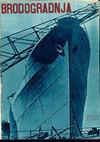双起重船在上部模块协同提升过程中的耦合响应分析
IF 3.9
4区 工程技术
Q1 ENGINEERING, MARINE
引用次数: 0
摘要
海上组装和拆卸作业具有数十亿美元的市场潜力。多船协同吊装已成为综合海上设施组装和拆卸的一种新操作模式。因此,本文研究了双起重船在协同起重作业中的水动力相互作用。本文使用商业软件 SESAM 对多体作业过程中的耦合运动进行了模拟。通过将上部运动、船舶运动和垂直起重臂载荷的数值结果与实验测量结果进行比较,验证了协同吊装中耦合运动数值模型的可行性。研究了波浪航向和周期对协同作业期间上部模块、双起重船和起重臂流体动力响应的影响。详细分析了它们的影响模式和机制。研究结果表明,横波和头波对上部模块和双体船造成了明显的倾斜和俯仰运动,但斜波对起重臂造成的垂直载荷最大。在斜波条件下,上部模块和船舶的运动响应随着波浪周期的延长而增加,与逐渐上升的倾角和俯仰相比,滚动运动对大周期更为敏感。本文章由计算机程序翻译,如有差异,请以英文原文为准。
Coupled response analysis of dual lifting vessels during collaborative lifting topside module
Offshore assembly and disassembly operations represent a multi-billion-dollar market potential. Collaborative lifting by multiple vessels has emerged as a new operating paradigm for integrated offshore facilities assembly and disassembly. Hence, this paper investigates the hydro-dynamic interaction of dual lifting vessels in collaborative lifting operations. The coupled motions during multi-body operations are simulated using the commercial software SESAM. The feasibility of the numerical model for coupled motions in collaborative lifting is verified by comparing the numerical results of topside motions, vessel motions, and vertical lifting arm loads against experimental measurements. The effects of wave heading and period on the hydrodynamic responses of the topside module, dual lifting vessels, and lifting arms during collaborative operations are studied. Their influence patterns and mechanisms are analysed in detail. The results show that transverse waves and head wave induce significant heave and pitch motions of the topside module and vessels, but the maximum vertical loads on the lifting arms occur in oblique waves. The motion responses of the topside module and vessels increase with longer wave periods under the oblique sea condition, and roll motions are more sensitive to large periods compared to the gradual rise in heave and pitch.
求助全文
通过发布文献求助,成功后即可免费获取论文全文。
去求助
来源期刊

Brodogradnja
ENGINEERING, MARINE-
CiteScore
4.30
自引率
38.90%
发文量
33
审稿时长
>12 weeks
期刊介绍:
The journal is devoted to multidisciplinary researches in the fields of theoretical and experimental naval architecture and oceanology as well as to challenging problems in shipbuilding as well shipping, offshore and related shipbuilding industries worldwide. The aim of the journal is to integrate technical interests in shipbuilding, ocean engineering, sea and ocean shipping, inland navigation and intermodal transportation as well as environmental issues, overall safety, objects for wind, marine and hydrokinetic renewable energy production and sustainable transportation development at seas, oceans and inland waterways in relations to shipbuilding and naval architecture. The journal focuses on hydrodynamics, structures, reliability, materials, construction, design, optimization, production engineering, building and organization of building, project management, repair and maintenance planning, information systems in shipyards, quality assurance as well as outfitting, powering, autonomous marine vehicles, power plants and equipment onboard. Brodogradnja publishes original scientific papers, review papers, preliminary communications and important professional papers relevant in engineering and technology.
 求助内容:
求助内容: 应助结果提醒方式:
应助结果提醒方式:


